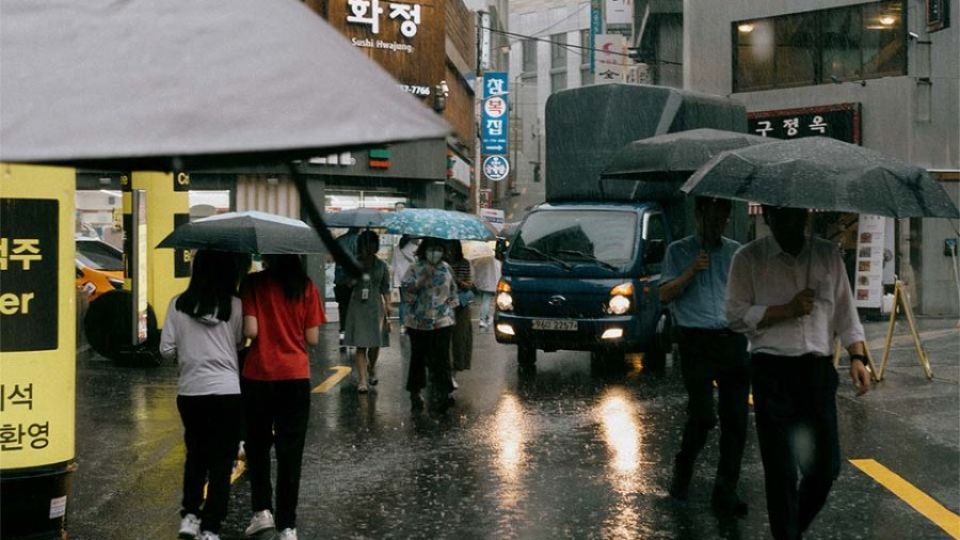September 24, 2024
SEOUL – The scorching summer heat wave persisted until the end of Chuseok (Korean Thanksgiving) holidays Sept. 16-18, usually a time when the weather stars to cool. Just two days after the holidays ended, record heavy rains began to batter the nation, particularly its southern regions.
Daily precipitation records for September were broken in many sites.
Hourly rainfall rose to a high of 112.2 millimeters in Jindo, South Jeolla Province. Precipitation at the Yeosu Industrial Complex in the province Sept. 19-21 was 401 mm. Changwon and Gimhae in South Gyeongsang Province endured a total of 529 mm and 428 mm of rain, respectively, Sept. 20-21. According to the Korea Meteorological Agency, hourly (104.9 mm) and daily (397.7 mm) maximum precipitation in Changwon were at once-in-200-year levels.
The damage from just a few days of torrential rain was not small: sinkholes, landslides, falling rocks, flooding and power outages. About 1,500 residents in seven cities and provinces were evacuated.
Pulasan, the 14th typhoon of the year, made landfall in eastern China and moderated to heavy rain and strong winds, then changed its course toward the Korean Peninsula and passed between the Jeju Island and the southern coast of the peninsula, bringing a lot of rain along the way.
The extremely hot weather, which was in full swing until a few days ago, is said to be fading away after the rain, but there are concerns over the chance of an autumn typhoon heading toward the peninsula now that the atmospheric pressure over the country has changed.
Considering the fact that autumn typhoons have damaged the peninsula more than summer ones in recent years, it is necessary to check again our precautions in the event of such disasters. Soil erosion due to the heavy rain last week is feared to cause secondary damage such as embankment collapses and additional sinkholes.
These days, extreme weather changes are no longer exceptional. With the climate crisis deepening in Korea and worldwide, extreme heat waves and rainfall are getting more and more extreme. Dangerous weather events including droughts and floods are becoming more frequent.
Last year, the longest-ever drought came to a close in May, followed by near-record summer precipitation. This year, the heat wave lasted until after Chuseok. It was the first heat wave to continue past mid-September since the introduction of the heat wave warning system in 2008.
According to the Korea Disease Control and Prevention Agency, there were 3,505 confirmed cases of heat-related illnesses reported nationwide from May 20 to Sept. 10. A joint study by three local universities found that complaints to doctors of depression symptoms increased 13 percent in 2021 for every 1-degree Celsius rise in the annual average temperature over that before climate crisis. According to the Environment Ministry, extreme heavy rains have caused damage worth more than 1.6 trillion won ($1.19 billion) and 85 casualties for the past three years.
Extreme weather events are not things to come. They are upon us as real threat. Next year, heat waves may become more intense than this year, and precipitation records may be broken again as well. The government checks measures against typhoons and torrential rains every year, but its inspections should not end up as mere formalities. Meticulous inspections are required.
Above all, systems for speedy and correct weather forecasts and early alerts must be expanded to reduce flood-related damage. The government’s ability to respond to a disaster should be reinforced continuously through long-term plans. It will need to start with the basics: storm water drain projects.
In late July, the government announced 14 candidate sites for new flood-control dams to be built in a bid to respond to climate change. It is scheduled to hear opinions from residents but it may need to persuade them actively. The older generation tends to be less sensitive to climate change than younger ones. The government should make them understand that weather is now frequently extreme and that it is important to implement proactive measures to respond to and reduce climate change.
The government must brace for the possibility of a typhoon coming to the Korean Peninsula this fall, while preparing long-term anti-disaster precautions step by step.


